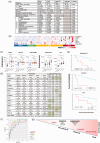Circulating markers of angiogenesis and endotheliopathy in COVID-19
- PMID: 33282193
- PMCID: PMC7691906
- DOI: 10.1177/2045894020966547
Circulating markers of angiogenesis and endotheliopathy in COVID-19
Abstract
Increase in thrombotic and microvascular complications is emerging to be a key feature of patients with critical illness associated with COVID-19 infection. While endotheliopathy is thought to be a key factor of COVID-19-associated coagulopathy, markers indicative of this process that are prognostic of disease severity have not been well-established in this patient population. Using plasma profiling of patients with COVID-19, we identified circulating markers that segregated with disease severity: markers of angiogenesis (VEGF-A, PDGF-AA and PDGF-AB/BB) were elevated in hospitalized patients with non-critical COVID-19 infection, while markers of endothelial injury (angiopoietin-2, FLT-3L, PAI-1) were elevated in patients with critical COVID-19 infection. In survival analysis, elevated markers of endothelial injury (angiopoietin-2, follistatin, PAI-1) were strongly predictive of in-hospital mortality. Our findings demonstrate that non-critical and critical phases of COVID-19 disease may be driven by distinct mechanisms involving key aspects of endothelial cell function, and identify drivers of COVID-19 pathogenesis and potential targets for future therapies.
Keywords: COVID-19; angiogenesis; endotheliopathy.
© The Author(s) 2020.
Figures

Update of
-
Circulating Markers of Angiogenesis and Endotheliopathy in COVID-19.medRxiv [Preprint]. 2020 Jul 1:2020.06.29.20140376. doi: 10.1101/2020.06.29.20140376. medRxiv. 2020. Update in: Pulm Circ. 2020 Nov 25;10(4):2045894020966547. doi: 10.1177/2045894020966547. PMID: 32637968 Free PMC article. Updated. Preprint.
References
-
- Hothorn T, Lausen B. On the exact distribution of maximally selected rank statistics. Comput Stat Data Anal 2003; 43: 121–137.
Grants and funding
LinkOut - more resources
Full Text Sources
Other Literature Sources
Miscellaneous

